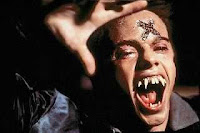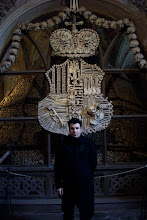Director: Tom Holland
Starring: Chris Sarandon, William Ragsdale, Amanda Bearse, Roddy McDowall, Stephen Geoffreys, Johnathan Stark.
At the start of the film, Charlie Brewster (Ragsdale) is watching a horror movie show hosted by Peter Vincent (McDowall) who is a Peter Cushingesque horror actor based on Vincent Price and Peter Cushing. For over a year he has been trying to sleep with his pretty, virginal girlfriend Amy (Bearse) only to grow constantly frustrated at her frigidity.
When Amy finally relents, Charlie notices that the vacant house next to his bedroom has two new occupants, who for some reason are carrying a coffin into the basement. He becomes instantly obsessed and Amy storms out angry at Charlie ignoring her.
That night, a prostitute asks Charlie if she has the right address, and he says she needs to go next door to the new neighbours. He mentions the neighbour to his mother who hopes that he isn't gay, and he retorts that he's not (due to the prostitute that he doesn't mention). In his room he hears a scream next door, and the lights next door go out.
At school, Charlie tells his best friend Evil Ed (Geoffreys) about the neighbour and is embarrassed by Amy with a pie in the face when he ignores her once more talking about his mysterious neighbour. He is horrified to see that the woman he saw has turned up dead, and Evil mentions that latest murder victims have been decapitated.
That night he sees a naked woman with one of the men about to do the deed when he freaks out at the long teeth the man has. The man notices Charlie watching him from a dark room, and he closes the window blind with a clawed hand. He sees the two men carry out the dismembered bodies in garbage bags later on, and goes to the police the next day telling them he knows who the serial killer is.
A policeman goes to the house with Charlie and interviews the flatmate Billy Cole who says Jerry is out of town. Charlie notices an old painting that resembles Amy and growing frustrated at Billy lying tells the policeman to check the cellar because Jerry is there sleeping the sleep on the undead away from the burning sun.
The policeman leaves threatening Charlie with imprisonment, and he flees to Evil's house and asks for advice (why is this he watches enough vampire films to know their weaknesses!) Evil states the most important rule is that a vampire must be invited into a house by the rightful owner to gain entry.
He comes home to find that his mother has invited Jerry over for tea to get to know each other, and Jerry asks for permission to visit anytime. (This is in reference to my last article: Jerry needs permission to enter into a mortal's dwelling, and in asking for repeated permission this could either mean that he needs permission every time, or just states this to torment Charlie who knows the truth).
Later that night Charlie faces off with Jerry in his room barely surviving. Jerry trashs his car in retaliation for interferring with his life and staking his hand with a pencil.
Charlie's next step in gaining help with destroying the vampire is to visit his idol Peter Vincent at the TV studio who has just been fired because of the growing popularity with slasher films compared to jaded vampire films. After hearing Charlie's story, Peter claims Charlie is deranged and leaves.
In desperation to save their friend from commiting murder they visit Peter Vincent and pay him money to perform vampire tests on Jerry with Charlie present in two nights time. They all arrive, Peter hands Jerry tap water still not believing Charlie's claims, and Jerry becomes enamoured with Amy who is the spitting image of his mysterious lost love. They quickly leave however when on a whim Peter looks in a small compact mirror and notices that Jerry does not cast a reflection, dropping and shattering it in shock. Soon after they leave Jerry steps on the broken mirror fragment to realise he has to destroy them all for his own safety.
Jerry stalks them on the way home, turning Evil after he leaves Charlie and Amy and sets him on Peter at his apartment. Amy and Charlie run into a club only for Jerry to kidnap her, killing several bouncers in the process. Evil almost succeeds in killing Peter but since he is a newborn vampire is easily overcome by Peter's crucifix and he jumps through the window.
Jerry contacts Charlie to tell him to return to Jerry's house the next night alone with Peter is he ever wishes to see Amy again. Jerry turns Amy that night, Charlie and Peter come to the house to do battle, only for Peter to realise his crucifix has not effect on Jerry. He must have upmost Faith in the crucifix for it to work on a Master vampire. Billy knocks out Charlie and Peter flees next door to Charlie's house to find Evil in his mother's bed. Evil takes the form of the wolf to kill Peter after crashing through railing luckily stakes Evil with a broken piece. He removes the stake from Evil's reverted human form and leaves to save Charlie once more.
Charlie wakes locked in a room with Amy who is angry with Charlie for abandoning her with Jerry, and attacks Charlie. Peter returns to the house and frees Charlie from the room, and tells Charlie he must kill Jerry if he wishes to save Amy. Peter finds his Faith and wards off Jerry who with the coming sunlight flees to his coffin after the hunters destroy Billy who crumples to goo and bugs after getting staked through the heart.
They find Jerry's coffin in a secret compartment in the basement and are almost overcome unti the begin smashing windows trapping Jerry in bars of sunlight. Breaking an entire window Jerry is pinned to wall and his flesh is flayed by sunlight until he is utterly destroyed. Amy returns to humanity, and Peter returns back to television hosting B-grade Alien invasion films. Charlie and Amy are about to make out when he notices two red eyes in Jerry's old house staring at him, but dismisses them as his imagination. The film ends with Evil laughing, saying "Oh you're so cool Brewster". Peter removing the stake from Evil's body has resurrected him similar to the Dracula films.
****
This is one of the best vampire movies ever made. The homage to Peter Cushing and old vampire films, the Classical vampire of Jerry Dandridge who can become bat, wolf and mist, his ghoul-like servant Billy and some poor teens who get in over their heads makes a perfect combination along with a pumping 80s soundtrack.
Sarandon has the right amount of charm and menance to portray Dandridge and he rates up their with my favourite evil vampires alongside Radu and Yorga. Classical Vampires are my favourite breed of vampires, and unfortunately they are a dying breed.
This film is a must for any vampire fan, if you don't own it or at least have never seen it, you should be ashamed of yourself and not call yourself a vampire junkie.
My Grade is A+

















.jpg)





















